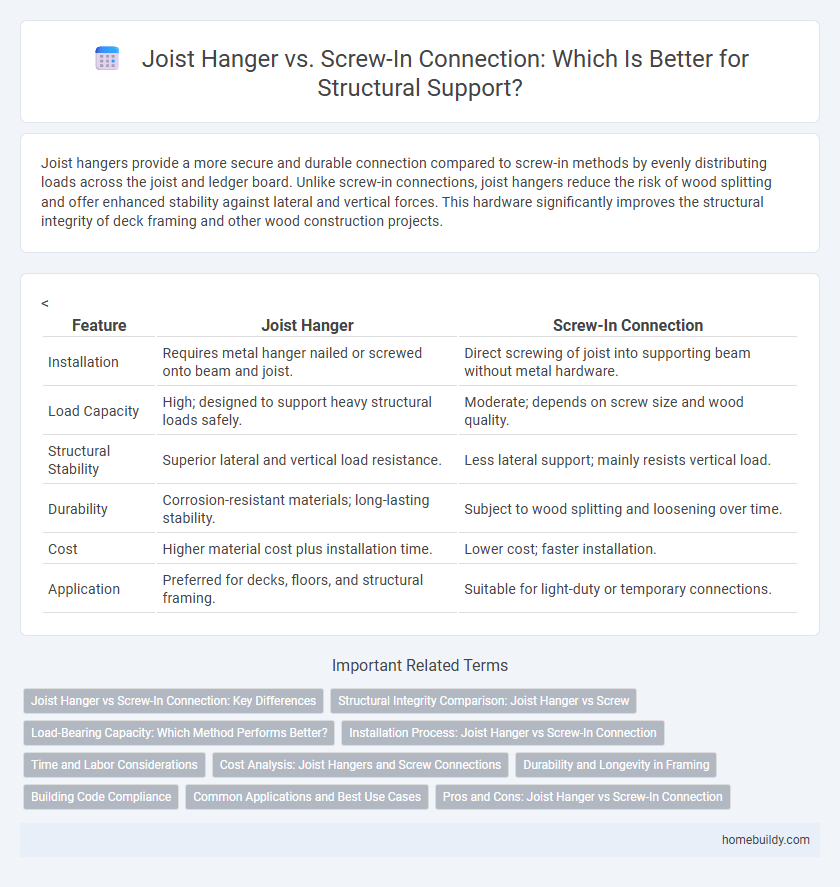Joist hangers provide a more secure and durable connection compared to screw-in methods by evenly distributing loads across the joist and ledger board. Unlike screw-in connections, joist hangers reduce the risk of wood splitting and offer enhanced stability against lateral and vertical forces. This hardware significantly improves the structural integrity of deck framing and other wood construction projects.
Table of Comparison
| Feature | Joist Hanger | Screw-In Connection |
|---|---|---|
| Installation | Requires metal hanger nailed or screwed onto beam and joist. | Direct screwing of joist into supporting beam without metal hardware. |
| Load Capacity | High; designed to support heavy structural loads safely. | Moderate; depends on screw size and wood quality. |
| Structural Stability | Superior lateral and vertical load resistance. | Less lateral support; mainly resists vertical load. |
| Durability | Corrosion-resistant materials; long-lasting stability. | Subject to wood splitting and loosening over time. |
| Cost | Higher material cost plus installation time. | Lower cost; faster installation. |
| Application | Preferred for decks, floors, and structural framing. | Suitable for light-duty or temporary connections. |
Joist Hanger vs Screw-In Connection: Key Differences
Joist hangers provide metal support brackets designed to securely hold wood joists to beams, ensuring structural stability and load distribution, while screw-in connections rely on screws drilled directly into wood for attachment. Joist hangers offer greater resistance to lateral forces and reduce wood splitting compared to screw-in connections, which can loosen over time under stress. The use of joist hangers enhances safety and durability in construction by facilitating easier inspections and consistent alignment of framing components.
Structural Integrity Comparison: Joist Hanger vs Screw
Joist hangers provide superior structural integrity compared to screw-in connections by evenly distributing load across the joist and ledger, reducing the risk of wood splitting and connection failure. Engineered steel joist hangers are rated for specific load capacities and resist shear and uplift forces more effectively than screws alone. In contrast, screw-in connections rely on the shear strength of fasteners and wood fiber, making them more susceptible to loosening under dynamic or heavy loads.
Load-Bearing Capacity: Which Method Performs Better?
Joist hangers provide superior load-bearing capacity compared to screw-in connections by evenly distributing weight across the hanger and fasteners, reducing stress on individual components. Engineered steel hangers are tested to meet strict building codes, ensuring consistent performance under heavy loads, whereas screw-in connections often rely on wood integrity and fastener strength, which can vary. Structural engineers typically specify joist hangers for critical load-bearing applications to maximize safety and durability in framing systems.
Installation Process: Joist Hanger vs Screw-In Connection
Joist hanger installation requires precise alignment and the use of specific connectors like nails or screws designed for metal, ensuring a secure hold between joists and beams. Screw-in connections involve driving screws directly through the joist into the supporting structure, which can be faster but may lack the uniform load distribution provided by joist hangers. Proper installation of joist hangers reduces the risk of structural failure by evenly distributing forces across the connection.
Time and Labor Considerations
Joist hangers significantly reduce installation time compared to screw-in connections by providing a straightforward attachment process that requires fewer fasteners and less alignment effort. Using pre-formed metal brackets streamlines labor, minimizing the need for precise drilling and increasing overall job efficiency on framing projects. This time-saving advantage lowers labor costs and accelerates project timelines for both residential and commercial wood framing applications.
Cost Analysis: Joist Hangers and Screw Connections
Joist hangers generally offer a more cost-effective solution compared to screw-in connections due to reduced labor time and increased installation efficiency. While joist hangers require upfront hardware expenses, their precision and standardization minimize errors and rework costs, ultimately lowering overall project expenses. Screw-in connections may save on initial hardware costs but often incur higher labor and maintenance costs over time.
Durability and Longevity in Framing
Joist hangers offer superior durability and longevity in framing due to their engineered metal design that evenly distributes loads and resists corrosion. Screw-in connections may loosen over time under repetitive stress and environmental conditions, compromising the structure's integrity. Using joist hangers minimizes maintenance and extends the lifespan of framed structures by ensuring stable, long-lasting support.
Building Code Compliance
Joist hangers provide superior building code compliance compared to screw-in connections by ensuring structural stability and load distribution as required by standards like the International Building Code (IBC). Building codes often specify metal connectors, such as joist hangers, to meet minimum safety requirements for framing connections in wood construction. Screw-in connections may fail to comply due to insufficient load ratings and potential for wood splitting, leading to noncompliance issues during inspections.
Common Applications and Best Use Cases
Joist hangers provide superior load distribution and are commonly used in heavy timber framing, deck construction, and structural repairs where code compliance and safety are critical. Screw-in connections are best suited for lighter applications such as temporary setups, DIY projects, or where ease of installation is prioritized over maximum strength. Structural engineers recommend joist hangers in commercial buildings and multi-story residential frameworks due to their standardized performance and reliability under dynamic loads.
Pros and Cons: Joist Hanger vs Screw-In Connection
Joist hangers provide superior structural support and load distribution compared to screw-in connections, ensuring increased stability and safety in framing applications. However, they require precise installation and can be more time-consuming, whereas screw-in connections offer quicker, more flexible assembly but may compromise long-term strength and durability under heavy loads. Selecting joist hangers is ideal for code-compliant, high-load scenarios, while screw-in connections suit lighter, temporary structures with less stringent strength requirements.
joist hanger vs screw-in connection Infographic

 homebuildy.com
homebuildy.com